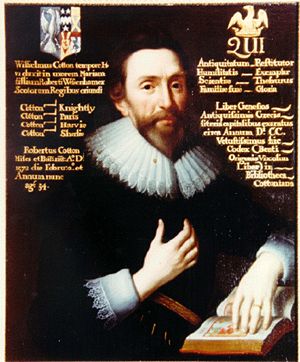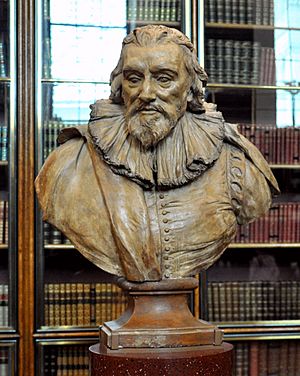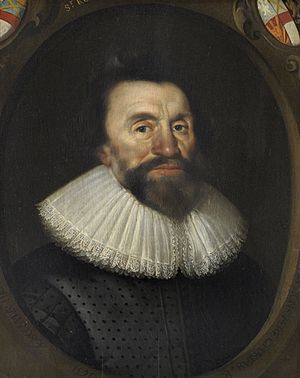Sir Robert Cotton, 1st Baronet, of Connington facts for kids
Quick facts for kids
Sir Robert Cotton, 1st Baronet, of Connington
|
|
|---|---|

Portrait of Robert Cotton, commissioned 1626 and attributed to Cornelis Janssens van Ceulen
|
|
| Member of the English Parliament for Newtown |
|
| In office 1601–1601 Serving with Robert Wroth
|
|
| Preceded by |
|
| Succeeded by |
|
| Member of the English Parliament for Huntingdonshire |
|
| In office 1604–1611 Serving with Sir Oliver Cromwell
|
|
| Preceded by |
|
| Succeeded by |
|
| Member of the English Parliament for Old Sarum |
|
| In office 1624–1624 Serving with Michael Oldisworth
|
|
| Preceded by |
|
| Succeeded by |
|
| Member of the English Parliament for Thetford |
|
| In office 1625–1625 Serving with Framlingham Gawdy
|
|
| Preceded by |
|
| Succeeded by |
|
| Member of the English Parliament for Castle Rising |
|
| In office 1628–1629 Serving with Sir Thomas Bancroft
|
|
| Preceded by |
|
| Succeeded by | Parliament suspended until 1640 |
| Personal details | |
| Born |
Robert Bruce Cotton
22 January 1570/1 Denton, Cambridgeshire, England |
| Died | 6 May 1631 |
| Children | Sir Thomas Cotton, 2nd Baronet Roland Rowland Cotton (Saltonstall) II of Derby |
Sir Robert Bruce Cotton, 1st Baronet (born January 22, 1571 – died May 6, 1631) was an important English Member of Parliament and a collector of old books and documents. He lived at Conington Hall in Huntingdonshire, England. Sir Robert is best known for creating the famous Cotton library, a huge collection of ancient manuscripts.
Contents
Who Was Robert Cotton?
Robert Cotton was born on January 22, 1571, in Denton, Cambridgeshire. His father was Thomas Cotton, and his mother was Elizabeth Shirley. The Cotton family originally came from a place called Cotton in Cheshire.
Robert's Education and Early Interests
Robert went to The King's (The Cathedral) School and Westminster School. There, he was taught by William Camden, a famous historian and collector of old things. Camden inspired Robert to start studying history and collecting rare manuscripts.
When he was just 17, Robert began gathering old documents and notes about the history of Huntingdonshire. He then went to Jesus College, Cambridge, and later studied law. He started building a library that soon became even bigger and more important than the king's own collection of manuscripts.
Robert Cotton's Political Career
Robert Cotton became a Member of Parliament (MP) several times. He represented Newtown, Isle of Wight in 1601. Later, he was elected for Huntingdonshire in 1604.
He helped King James I create a new special title called "baronet". This title was passed down through families, like a noble title. But, unlike a peerage, it did not give the person a seat in the House of Lords. The king used this new title to raise money.
Cotton wrote a paper called Twenty-Four Arguments. In it, he suggested ways to make the king's power stronger against Catholic groups in England. This made King James I happy for a short time.
However, Robert Cotton believed that kings should trust Parliament. He wrote about this idea in his 1628 paper, The Dangers wherein the Kingdom now Standeth, and the Remedye. The king's ministers saw this as being against the king. They worried that Cotton's library was being used to support Parliament's arguments. Because of this, the king took away his library in 1630. It was only given back to his family after Robert died.
Robert Cotton's Role in Parliament

Robert Cotton supported James VI of Scotland becoming King of England after Queen Elizabeth I died. He wrote a paper defending James's claim to the throne. For this, he was made a knight in 1603.
In 1604, Cotton was elected to Parliament for Huntingdonshire. This was the same area his grandfather had represented. He worked on important committees, including those dealing with public complaints and special rules for Parliament members. He also helped with the bill about the Gunpowder Plot in 1605–06.
In 1606–07, he worked on a bill to fully unite Scotland and England. In 1610, he was again chosen for the Committee of Privileges. When the king's money was low, Cotton wrote Means for raising the king’s estate. In this work, he suggested creating the baronetcy, a new social rank.
Cotton was not elected to the 1614 Parliament. In 1621, he advised King James I on the case of Sir Francis Bacon. In 1624, Cotton was elected to represent Old Sarum. He was later elected for Thetford in 1625 and Castle Rising in 1628.
The Society of Antiquaries
In the late 1580s, Robert Cotton joined the Society of Antiquaries. This was a group of people who studied old things. His former teacher, William Camden, was also a member. Camden was a very important early historian. His 1586 book, Britannia, described the geography and history of Britain.
After his father died in 1592, Cotton became more involved in the Society. He rebuilt his family home, Conington Castle. In 1598, he returned to London and tried to get the Society to become a permanent academy for studying history. He even suggested combining his collection of manuscripts with the Queen's library to create a national library. However, the Queen did not approve this plan.
In the summer of 1600, the Society discussed ancient burial customs. This was probably because Camden and Cotton had recently visited Hadrian's Wall. There, they collected Roman coins, monuments, and fossils. This trip sparked Cotton's interest in Roman artifacts. Other historians sent him Roman stones and relics.
Cotton's studies of ancient history influenced many people. Other historians often looked to him for ideas. The last known meeting of the Society of Antiquaries was in 1607. But Cotton continued to collect old items.
Robert Cotton's Family Life
Around 1593, Robert Cotton married Elizabeth Brocas. She was from Theddingworth in Leicestershire and had inherited money. This marriage helped Robert's financial situation.
Robert and Elizabeth had one son, Sir Thomas Cotton, 2nd Baronet (1594–1662). Sir Thomas later married Margaret Howard, and they had a son named Sir John Cotton (born 1621).
Sir Robert Cotton had many friends and was known for his charm.
The Famous Cotton Library
The Cottonian Library was the largest private collection of manuscripts ever gathered. It was even bigger than the king's own library. Cotton's collection included many rare and ancient texts. Some of these are:
- The original handwritten book of Beowulf, written around the year 1000.
- The Lindisfarne Gospels, written in the seventh or eighth century.
- The Codex Alexandrinus, a fifth-century manuscript of the Greek Bible.
Cotton's house near the Palace of Westminster became a meeting place for scholars and the Society of Antiquaries. The library was later given to the nation by Cotton's grandson. Today, it is kept in the British Library.
The way Cotton organized his library is still used today when referring to his manuscripts. His library was in a room about 26 feet (8 meters) long and 6 feet (1.8 meters) wide. It had bookcases, each with a bust (a statue of the head and shoulders) of a famous person from ancient times on top. These busts were named after Roman emperors and empresses, like Julius, Augustus, Cleopatra, Faustina, Tiberius, Caligula, Claudius, Nero, Galba, Otho, Vitellius, Vespasian, Titus, and Domitian.
Today, manuscripts from his collection are named by the library, the bookpress (bust name), and a number. For example, the Beowulf manuscript is called Cotton Vitellius A.xv. The Pearl poem manuscript is Cotton Nero A.x.
The Cotton Library and His Family
Sir Robert Cotton started building his library shortly after his son, Thomas, was born in 1594. Between 1609 and 1614, he bought many works for his library when important people died. Sir Robert lived in London, while his wife and son stayed in the countryside.
His son, Thomas Cotton, studied and received his degree in 1616. That same year, Sir Robert Cotton returned to his family. At that point, Sir Thomas Cotton took on more responsibility for the family home and the library.

In 1620, Thomas Cotton married Margaret Howard. They had their first son, Sir John Cotton, in 1621. In 1622, Sir Robert Cotton moved permanently to The Cotton House, bringing the library with him. The library stayed there until his death nine years later in 1631. This move made it easier for members of Parliament and government workers to use the library's resources.
The Cotton Library was a very important source of information for many people. John Selden, a frequent visitor, said in 1623 that Cotton was very kind and willing to let students and government officials use his collection. The British Library still has a list of books that Selden borrowed from Sir Robert Cotton.
In 1629, King Charles I forced Sir Robert Cotton to close the library. The king believed that the library's contents could harm the interests of the Royalists (those who supported the king). In September 1630, Sir Robert and his son, Sir Thomas, asked to get access to their library again.
Sir Robert Cotton died in 1631 without knowing what would happen to his library. In his will, he left the library to his son, Thomas Cotton, to be passed down through the family. After his father's death, Sir Thomas Cotton married his second wife, Alice Constable, in 1640. They had a son, Robert Cotton, in 1644. Sir Thomas Cotton had less access to the library than his father did. However, he managed to protect and improve it during the English Civil War.
When Sir Thomas Cotton died on May 13, 1662, he followed his father's will. He passed the library down to his eldest son from his first marriage, Sir John Cotton.
On September 12, 1702, Sir John Cotton died. Before his death, he made arrangements for the Cotton Library to be bought by the nation of England through acts of Parliament. This was important because if the library had not been sold to the nation, it would have been inherited by John Cotton's two grandsons. Unlike the rest of the Cotton family, they could not read or write. This would have put the Cotton Library at risk of being broken up and sold off.
Selected Manuscripts from the Cotton Library
Here are some of the famous manuscripts that were part of the Cotton Library:
- Cotton Julius A.x Old English Martyrology
- Cotton Augustus II.106 Magna Carta: An original copy of 1215
- Cotton Cleopatra A.ii Life of St Modwenna
- Cotton Faustina A.x Additional Glosses to the Glossary in Ælfric's Grammar
- Cotton Tiberius B.v Labours of the Months
- Cotton Caligula A.ii "A Pistil of Susan" (a small part)
- Cotton Claudius B.iv Genesis
- Cotton Nero A.x. Pearl, Sir Gawain and the Green Knight
- Cotton Nero D.iv Lindisfarne Gospels
- Cotton Galba A.xviii Athelstan Psalter
- Cotton Otho C.i Ælfric's De creatore et creatura
- Cotton Vitellius A.xv Beowulf, Judith
- Cotton Vespasian D.xiv Ælfric's De duodecim abusivis
- Cotton Titus D.xxvi Ælfwine's Prayerbook
- Cotton Domitian A.viii Anglo-Saxon Chronicle (version E)
Images for kids
See also
- Anglo-Saxon literature



